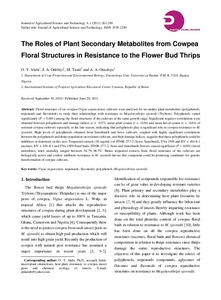| dc.contributor.author | Alabi, O.Y. |
| dc.contributor.author | Odebiyi, J.A. |
| dc.contributor.author | Tamò, M. |
| dc.contributor.author | Omoloye, A.A. |
| dc.date.accessioned | 2019-12-04T11:10:13Z |
| dc.date.available | 2019-12-04T11:10:13Z |
| dc.date.issued | 2011-06-20 |
| dc.identifier.citation | Alabi, O.Y., Odebiyi, J.A., Tamo, M. & Omoloye, A.A. (2011). The roles of plant secondary metabolites from cowpea floral structures in resistance to the flower bud thrips. Journal of Agricultural Science and Technology A, 262-269. |
| dc.identifier.issn | 2161-6256 |
| dc.identifier.uri | https://hdl.handle.net/20.500.12478/2028 |
| dc.description.abstract | Floral structures of six cowpea (Vigna unguiculata) cultivars were analysed for secondary plant metabolites (polyphenols,
terpenoids and flavonoids) to study their relationships with resistance to Megalurothrips sjostedti (Trybom). Polyphenols varied
significantly (P < 0.001) among the floral structures of the cultivars at the same growth stage. Significant negative correlations were obtained between polyphenols and damage indices (r = -0.57), mean adult counts (r = -0.56) and mean larval counts (r = -0.64) of resistant cowpea cultivars especially in the late season, indicating that polyphenols play a significant role in cowpea resistance to M. sjostedti. High levels of polyphenols obtained from Sanzibanili and Sewe cultivars, coupled with highly significant correlations between the polyphenols and thrips population on resistant cultivars, and their damage indices, suggests that these polyphenols could be inhibitors or deterrents in this case. Terpenoid extracts (10 mg/mL) of IT90K-277-2, Sewe, Sanzibanili, TVu 1509 and KV × 404-8-1 racemes; KV × 404-8-1 and TVu 1509 floral buds; IT90K-277-2, Sewe and Sanzibanili flowers caused significant (P < 0.001) larval mortalities, since mortality ranged between 56.7%-96.7%. Hence terpenoid extracts from floral structures of the cultivars are biologically active and confers antibiotic resistance to M. sjostedti larvae; this compound could be promising candidates for genetic transformation of cowpea cultivars. |
| dc.format.extent | 262-269 |
| dc.language.iso | en |
| dc.subject | Vigna Unguiculata |
| dc.subject | Terpenoids |
| dc.subject | Flavonoids |
| dc.subject | Polyphenols |
| dc.subject | Cowpeas |
| dc.subject | Cultivars |
| dc.subject | Metabolites |
| dc.subject | Flower Bud Thrips |
| dc.subject | Host Plant Resistance |
| dc.title | The roles of plant secondary metabolites from cowpea floral structures in resistance to the flower bud thrips |
| dc.type | Journal Article |
| dc.description.version | Peer Review |
| cg.contributor.affiliation | University of Ibadan |
| cg.contributor.affiliation | International Institute of Tropical Agriculture |
| cg.coverage.region | Africa |
| cg.coverage.region | West Africa |
| cg.coverage.country | Nigeria |
| cg.authorship.types | CGIAR and developing country institute |
| cg.iitasubject | Cowpea |
| cg.iitasubject | Grain Legumes |
| cg.journal | Journal of Agricultural Science and Technology A |
| cg.howpublished | Formally Published |
| cg.accessibilitystatus | Limited Access |
| local.dspaceid | 85841 |
| cg.targetaudience | Scientists |

